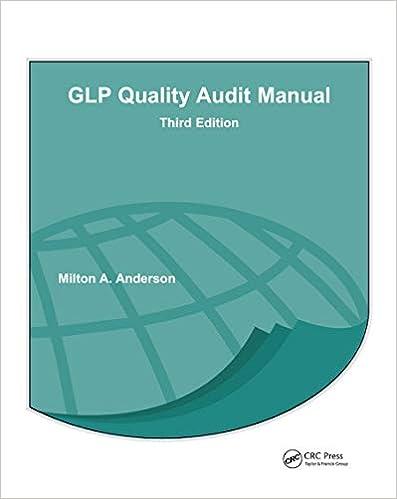Question
Gladstone Company tracks the number of units purchased and sold throughout each accounting period but applies its inventory costing method at the end of each
| Gladstone Company tracks the number of units purchased and sold throughout each accounting period but applies its inventory costing method at the end of each period, as if it uses a periodic inventory system. Assume its accounting records provided the following information at the end of the annual accounting period, December 31. |
| Transactions | Units | Unit Cost | |||||||
| Beginning inventory, January 1 | 1,500 | $ | 60 | ||||||
| Transactions during the year: | |||||||||
| a. | Purchase, January 30 | 2,600 | 72 | ||||||
| b. | Sale, March 14 ($100 each) | (1,150 | ) | ||||||
| c. | Purchase, May 1 | 1,300 | 90 | ||||||
| d. | Sale, August 31 ($100 each) | (1,600 | ) | ||||||
| Assuming that for Specific identification method (item 1d) the March 14 sale was selected two-fifths from the beginning inventory and three-fifths from the purchase of January 30. Assume that the sale of August 31 was selected from the remainder of the beginning inventory, with the balance from the purchase of May 1. |
| Required: | |
| 1. | Compute the amount of goods available for sale, ending inventory, and cost of goods sold at December 31 under each of the following inventory costing methods: (Round intermediate calculations to 2 decimal places and final answers to the nearest whole dollar amount.) |
| 2-a. | Of the four methods, which will result in the highest gross profit? | ||||||||
|
| 2-b. | Of the four methods, which will result in the lowest income taxes? | ||||||||
|
Part 2)
| Springer Anderson Gymnastics prepared its annual financial statements dated December 31. The company used the FIFO inventory costing method, but it failed to apply LCM to the ending inventory. The preliminary income statement follows: |
| Sales Revenue | $ | 160,000 | ||||
| Cost of Goods Sold | ||||||
| Beginning Inventory | $ | 20,000 | ||||
| Purchases | 101,000 | |||||
| Goods Available for Sale | 121,000 | |||||
| Ending Inventory (FIFO cost) | 38,140 | |||||
| Cost of Goods Sold | 82,860 | |||||
| Gross Profit | 77,140 | |||||
| Operating Expenses | 36,000 | |||||
| Income from Operations | 41,140 | |||||
| Income Tax Expense (20%) | 8,228 | |||||
| Net Income | $ | 32,912 | ||||
| Assume that you have been asked to restate the financial statements to incorporate LCM. You have developed the following data relating to the ending inventory: |
| Purchase Cost | Market Value per Unit | |||||||||||
| Item | Quantity | Per Unit | Total | |||||||||
| A | 2,000 | $ | 4.00 | $ | 8,000 | $ | 5.00 | |||||
| B | 800 | 5.80 | 4,640 | 2.90 | ||||||||
| C | 4,500 | 3.00 | 13,500 | 1.45 | ||||||||
| D | 2,000 | 6.00 | 12,000 | 4.00 | ||||||||
| $ | 38,140 | |||||||||||
| Required: | |
| 1. | Restate the income statement to reflect LCM valuation of the ending inventory. Apply LCM on an item-by-item basis. |
| 2. | Compare the LCM effect on each amount that was changed in requirement 1. (Decreases should be indicated by a minus sign.) |
Step by Step Solution
There are 3 Steps involved in it
Step: 1

Get Instant Access to Expert-Tailored Solutions
See step-by-step solutions with expert insights and AI powered tools for academic success
Step: 2

Step: 3

Ace Your Homework with AI
Get the answers you need in no time with our AI-driven, step-by-step assistance
Get Started


